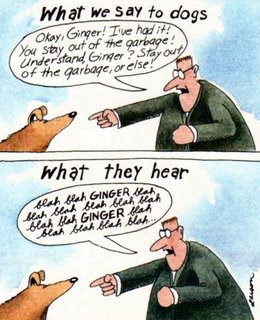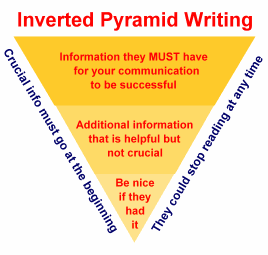Archive for the ‘Reading Notes’ Category
Public Opinion and Persuasion
Posted on: 04/30/2009
Here are my Chapter 9 notes for my Intro to PR class, these notes come from our book we have been using for the semester Public Relations: Strategies and Tactics
Public Opinion = the sum of individual opinions on an issue affecting those individuals; a collection of views held by persons interested in the subject.

Opinion Leaders: (as described by sociologists)
* highly interested in a subject or issue
* better informed on an issue than the average person
* avid consumers of mass media
* early adopters of new ideas
* good organizers who can get other people to take action
Persuasion is used for:
1. change or neutralize hostile opinions
2. crystallize latent opinions and positive attitudes
3. conserve favorable opinions
Persuasive Communication = the PR practitioner should be knowledgable about audience analysis, source credibility, appeal to self-interest, clarity of message, timing and context, audience participation, suggestions for action, content and structure of messages, and persuasive speaking.
Appeal to Self-Interest:
1. power
2. respect
3. well-being
4. affection
5. wealth
6. skill
7. enlightenment
8. physical and mental vitality
Propoganda – the deliberate and systematic attempt to shape perceptions, manipulate cognitions, and direct behavior to achieve a response that furthers the desired intent of the propagandist.
“What people in PR have to understand is not only do you have the facts on your side, you have to know how to communicate them.” – Peter Pitts, senior vice president of Manning, Selvage, & Lee
Press Releases (News Releases):
- Ivy Lee is known as the Father of News Releases
- story that you write with hopes of having it published in a mass media channel (i.e. TV, internet, newspapers, radio)
- Should be written in inverted pyramid style
Inverted Pyramid:
- start with 5 w’s and 1 h (Who, What, When, Where, Why, and How?)
- story formatted like this:

Guidelines for news release:
1. double-check ALL information
2. eliminate boldface and capital letters
3. include organization background
4. localize whenever possible
*Never send an internet news release as an e-mail attachment! (journalists very rarely open attachments, because it could be a virus)
Fact Sheets:
- usually 1-2 pages
- “cliff’s note” version of your organization
- 8 things the fact sheet may provide:
- organization’s full name
- products/services offered
- annual revenue
- number of employees
- names and bios of top executives
- markets served
- position in the industry
- any other pertinent details
Media Kits (press kits):
- prepared for major events or new product launches
- more than just a story and facts
- will include:
- main news release
- news feature about the development of the product/something similar
- fact sheets on product, organization, or event
- background info
- photos/drawings (with captions)
- bio material on spokesperson
- basic brochures
Pitches:
- PR people use pitches to convince a journalist that their story is something their readers want! (impossible to do over e-mail or phone if they’ve never met the reporter before)
E-mail:
- Most surveys show that editors and reporters prefer to recieve pr materials via e-mail.
- Tips for e-mailing news releases and other materials:
- don’t send HTML e-mails
- don’t send attachments unless specifically requested to do so
- use extended headlines at top of news release that give the key message or point
- keep it short! reporters hate to scroll through multiple screens
- use blind copy distribution!! (no reporter wants to know that they’re part of mass mailing..this lowers your chance of your story getting published!)
- continually update e-mail addresses
These are my chapter 14 notes from Public Relations: Strategies and Tactics by Dennis L. Wilcox and Glen T. Cameron and also from my own notes I took in my Intro to PR class at Georgia Southern University.
Notes from chapter 11 in Public Relations: Strategies and Tactics.

Generalizations made about audiences today:
* diversity is the most significant aspect of the mass audience in the United States
* the international audience for public relations has expanded swiftly
* technology can be used to segment the mass audience and compile related valuable information
* the public is increasingly visually oriented and seems to have a shorter attention span
* audiences are increasingly taking controls of information streams
* fervent support is generated for single issues
* heavy emphasis is placed on personality and celebrity
* strong distrust of authority and suspicion of conspiracy can arise from sensationalistic investigative reporting
Generation Y (born after 1980…that’s my crowd!):
* it has been projected that Gen. Y will spend 23 years online, which will have some interesting impacts
Generation X (born 1965-1980…my parents aren’t even in this one)
Baby Boomers (born between 1946 and 1964…hi mom and dad!)
* they comprise a market of 76 million people (28% of US population)
* “Those wishing to be successful in the market can’t ignore the boomer numbers, the wealth, and the spending power they have” – Pat Conroy, vice chairman of consumer business practices for Deloitte and Touche accounting firm
Seniors (men and women 65 years or older, although the AARP include everyone that is over the age of 50…wow, huge difference)
* financially, they are better off than the stereotypes suggest
* the Census Bureau found that people ages 65 to 74 have more discretionary income than any other group (median assets = $108,885)
Hispanics: the average person listens to 26-30 hours of radio per week (13% more than the general population)
Asian Americans: Calif. is home to 70% of the US’s more than 650 Asian-American focused tv channels, radio stations, and newspapers. San Francisco’s population is 19.2% Asian
**PR professionals must be aware of emerging audiences and pay attention to them (catholic/evangelical groups, gay/lesbian community, disabled, and women)
Supermoms: (5.4% of mothers)
* have at least 75 friends with whom they keep in touch
* give their friends advice on what to buy and restaurants to try
* spend at least nine hours a week on the internet
* participate in online chats and discussion
Public Opinion and Persuasion
Posted on: 04/30/2009
Here are my Chapter 9 notes for my Intro to PR class, these notes come from our book we have been using for the semester Public Relations: Strategies and Tactics
Public Opinion = the sum of individual opinions on an issue affecting those individuals; a collection of views held by persons interested in the subject.

Opinion Leaders: (as described by sociologists)
* highly interested in a subject or issue
* better informed on an issue than the average person
* avid consumers of mass media
* early adopters of new ideas
* good organizers who can get other people to take action
Persuasion is used for:
1. change or neutralize hostile opinions
2. crystallize latent opinions and positive attitudes
3. conserve favorable opinions
Persuasive Communication = the PR practitioner should be knowledgable about audience analysis, source credibility, appeal to self-interest, clarity of message, timing and context, audience participation, suggestions for action, content and structure of messages, and persuasive speaking.
Appeal to Self-Interest:
1. power
2. respect
3. well-being
4. affection
5. wealth
6. skill
7. enlightenment
8. physical and mental vitality
Propoganda – the deliberate and systematic attempt to shape perceptions, manipulate cognitions, and direct behavior to achieve a response that furthers the desired intent of the propagandist.
“What people in PR have to understand is not only do you have the facts on your side, you have to know how to communicate them.” – Peter Pitts, senior vice president of Manning, Selvage, and Lee
Communication
Posted on: 03/30/2009
Chapter 7 notes from my textbook Public Relations Strategies and Tactics
To be an effective communicator a person must have basic knowledge of:
- what constitutes communication and how people receive the messages
- how people process information and change their perceptions
- what kinds of media and communication tools are most appropriate for a particular message
A communicator should ask if the message is:
- appropriate
- meaningful
- memorable
- understandable
- believable to the prospective recipient
5 possible objectives for a communicator:
- message exposure (provides message to mass media)
- accurate dissemination of the message (basic info stays intact as it’s transmitted through various media)
- acceptance of the message (audience retains and accepts the message as valid)
- attitude change (audience believes the message and makes verbal or metal commitment to change behavior because of it)
- change in overt behavior (audience actually change current behavior)
Two types of audiences:
- Passive audiences (only pay attention if they think you’re entertaining and offer a diversion)
- Active audiences (actually interested in what you are talking about and actively seek information)
Being Memorable:
Do These:
- properly and effectively use language
- write clearly
- use symbols, acronyms, and slogans
Avoid These:
- jargon (words you understand/use, but others don’t)
- avoid cliches and hype words
- avoid euphemisms (sounds better than what it is)
- avoid discriminatory language
5-stage adoption process:
- awareness
- interest
- evaluation
- trail
- adoption
5 factors that affect the adoption process:
- relative advantage
- compatibility
- complexity
- trialability
- observability
Research
Posted on: 03/30/2009
Chapter 5 notes from Public Relations Strategies and Tactics & also my own notes from my Intro to PR class!
Effective PR is a process & the first step in that process is Research.
Defining the Research Role:
– What is the problem?
– What kind of information is needed?
– How will the results of the research be used?
– What specific public(s) should be researched?
– Should the organization do the research in-house or hire an outside consultant?
– How will the research data be analyzed, reported, or applied?
– How soon will the results be needed?
– How much will the research cost?
PR Professionals use research in the following ways:
- To achieve credibility with management
- To define audiences and segment publics
- To formulate strategy
- To test messages
- To help management keep in touch
- To prevent crises
- To monitor the competition
- To sway public opinion
- To generate publicity
- To measure success
Research Techniques:
- Secondary research – uses existing information in books, magazine articles, electronic databases, etc.
- Qualitative research – includes:
- content analysis
- interviews
- focus groups
- copy testing
- ethnographic techniques
3. Quantitative research – PR professionals conduct polls and surveys using highly precise scientific sampling methods
PR Departments and Firms
Posted on: 03/30/2009
Chapter 4 notes from Public Relations Strategies and Tactics for my Intro to PR class
Importance of organizational structure:
Having influence in the company based on 4 factors..
1. perception of value by top management
2. practitioners taking on the managerial role
3. reporting to the CEO
4. years of professional experience
Names of Departments:
a PR department goes by many names, most often it isn’t “public relations”. Terms like “corporate communications” or “communications” outnumber “public relations”. Other names used to PR departments include: corporate relations, marketing and corporate affairs, investor relations, public affairs, marketing communications, community relations, & external affairs.
Public Relations firms provide a variety of services, such as:
– Marketing communications (involves promotion of products and services through such tools as news releases, feature stories, special events, brochures, etc.)
– Executive speech training (top executives are coached on public affairs activities)
– Research & evaluation (scientific surveys are conducted to measure public attitudes and perceptions)
– Crisis Communication (management is counseled on what to say and do in an emergency such as an oil spill or a recall of an unsafe product)
– Media analysis (appropriate are examined for targeting specific messages to key audiences)
– Community relations (management is counseled on ways to achieve official and public support for such projects as building or expanding a factory)
– Events management (news conferences, anniversary celebrations, rallies, symposiums, and national conferences are planned and conducted)
– Public affairs (materials and testimony are prepared for government hearing and regulatory bodies, and background briefings are prepared)
– Branding and corporate reputation (advice is given on programs that establish a company brand and its reputation for quality)
– Financial relations (management is counseled on ways to avoid takeover by another firm and effectively communicate with stockholders, security analysts, and institutional investors)
Advantages of PR firms:
– objectivity
– a variety of skills and expertise
– extensive resources
– international jobs
– offices throughout the country
– special problem-solving skills
– credibility
Disadvantages of PR firms:
– superficial grasp of a client’s unique problems
– lack of full-time commitment
– need for prolonged briefing period
– resentment by internal staff
– need for strong direction by top management
– need for full information and confidence
– costs
Fees & Charges:
The 3 most common methods a pr firm charges:
1. Basic hourly fee, plus out-of-pocket expenses. (Commonly used by attorneys, accounting firms, and management consultants)
2. Retainer fee. (Basic monthly charge billed to the client….the # of hours the firm will spend on an account each month. out-of-pocket expenses are billed separately)
3. Fixed project fee. (PR firms will agree to a specific project like an annual report, newsletter, or special event for a fixed fee. Least popular among PR firms because it is difficult to predict all work & expenses in advance)
Ethics and Professionalism
Posted on: 03/30/2009
Reading notes from Chapter 3 in Public Relations Strategies and Tactics and notes taken during my Intro to PR class
What is Ethics?
– how we should live our lives
– focuses on questions about what is right or wrong, fair or unfair, caring or uncaring, good or bad, responsible or irresponsible, and the like.
3 Ethical Orientations:
1. Absolute – Every decision is right or wrong
2. Existential – Decision made on basis of immediate practical choice. (aka: “it seemed right at the time”)
3. Situational – what will the least amount of harm or the most amount of good. (does it make sense?)
Decisons must satisfy:
1. public interest
2. their employer
3. their professional organization’s code of ethics
4. their own personal values
Professionalism:
– “We act as publicists, yet we talk of counseling. We perform as technologists in communication, but we aspire to be decision-makers dealing in policy.”
– A practitioner should have:
* a sense of independence
* a sense of responsibility to society and the public interest
* manifest concern for the competence and honor of the profession as a whole
* a higher loyalty to the standards of the profession and fellow professionals than to the employer of the moment. the reference point in all public relations activity must be the standards of the profession and not those of the client or the employer.
Licensing:
1. define the practice of public relations
2. establish uniform educational criteria
3. set uniform professional standards
4. protect clients and employers from imposters and charlatans
5. protect qualified practitioners from unfair competition from the unethical and unqualified
6. raise the overall credibility of public relations practitioners
Accreditation:
– practitioners voluntarily go through a process in which they are “certified” by a national organization that they are competent, qualified professionals.
Ethics in Individual Practice:
“To thine own self be true”
– be honest at all times
– convey a sense of business ethics based on your own standards and those of society
– repsect the integrity and position of your opponents and audiences
– develop trust by emphasizing substance over triviality
– present all sides of an issue
– strive for a balance between loyalty to the organization and duty to the public
– don’t sacrifice long-term objectives for short-term gains\
– be prepared to sacrifice security for standards
Ethical Dealings with News Media:
– Achieve trust by avoiding..
* junkets of doubtful news value
* extravagant parties
* expensive gifts
* personal favors